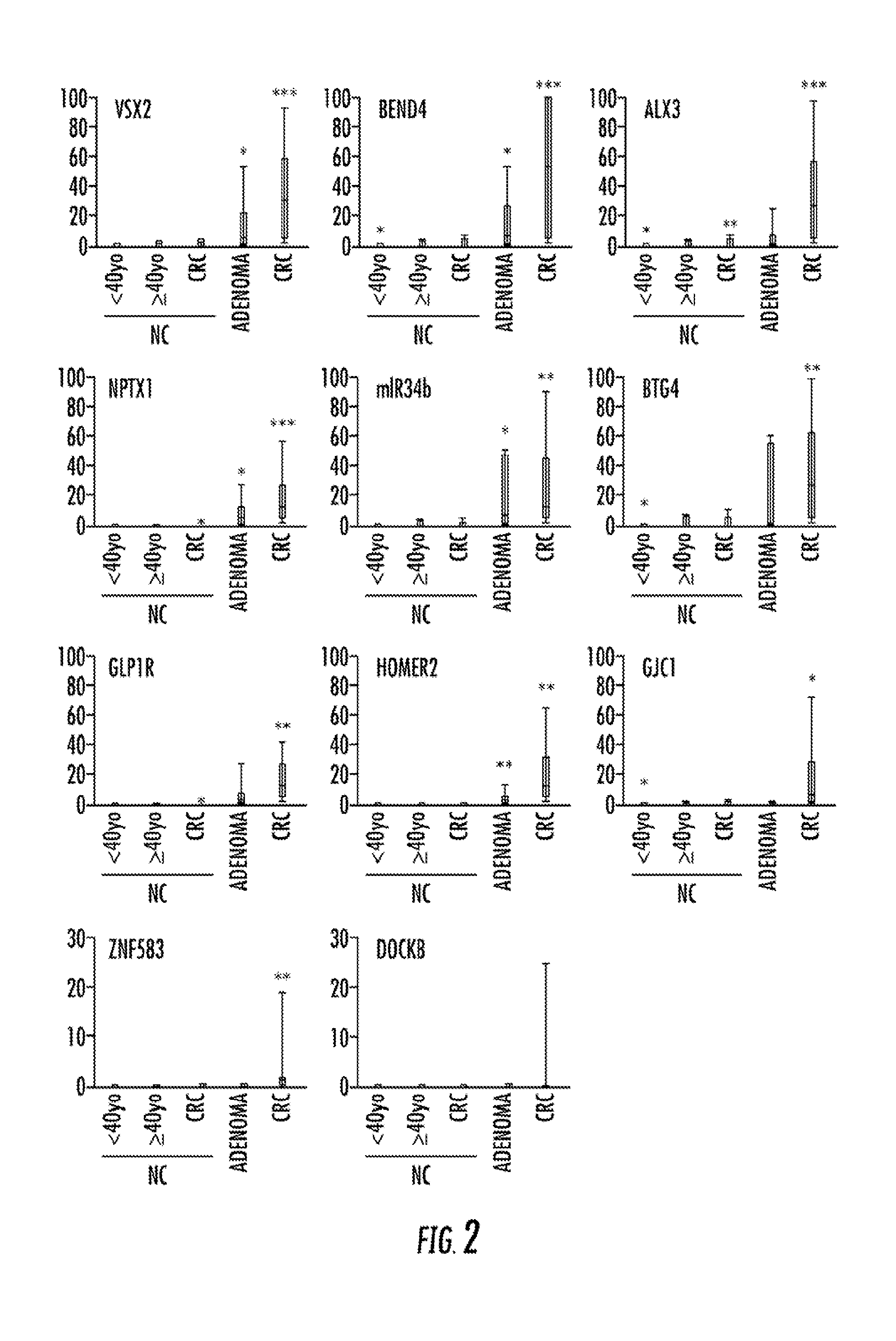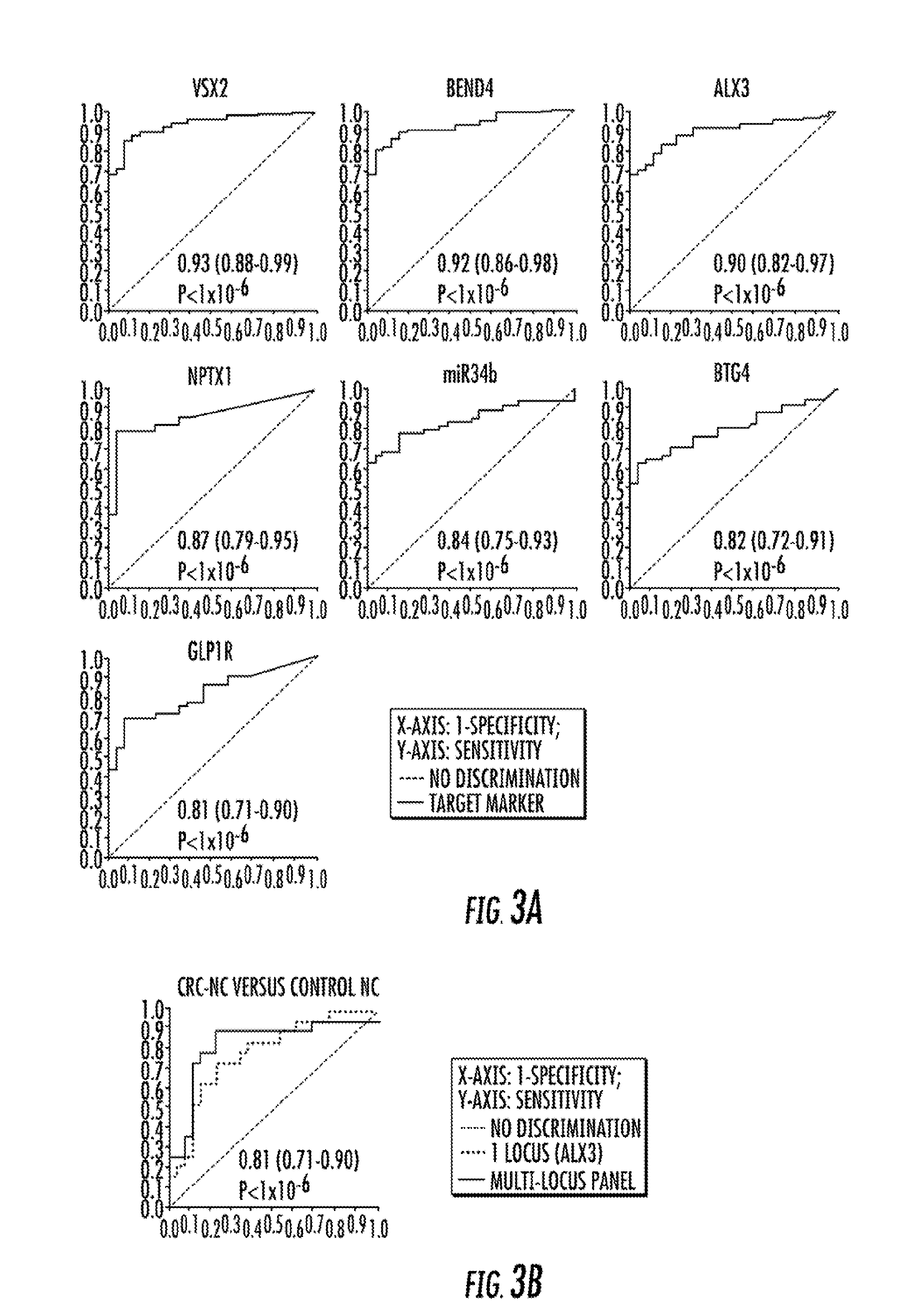Novel DNA hypermethylation diagnostic biomarkers for colorectal cancer
- Summary
- Abstract
- Description
- Claims
- Application Information
AI Technical Summary
Benefits of technology
Problems solved by technology
Method used
Image
Examples
example 1
Microarray Screening
[0124]Methylated DNA microarray analysis was performed by MCAM methodology. See Estecio et al., 17 GENOME RES. 1529-36 (2007). Seventeen primary CRCs and eight non-neoplastic colonic mucosae (NCs) from colonic neoplasia-free control subjects who were 40 years of age or older (control NCs) were analyzed (FIG. 6). Aged control individuals were studied to avoid mistakenly identifying age-associated hypermethylation targets as neoplasiaspecific hypermethylation events. Matching nonneoplastic colonic tissues from CRC cases (hereinafter referred to as NC-CRC) were not used as controls, since these tissues may already carry hypermethylation events linked to an increased risk of carcinogenic progression due to a “field defect.” See Belshaw et al., 31 CARCINOGENESIS 1158-63 (2010), Svrcek et al., 59 GUT 1516-26 (2010), Nosho et al., 137 GASTROENTEROLOGY 1609-20 (2009), and Shen et al., 97 J. NAT. CANCER INST. 1330-38 (2005).
[0125]The majority of analyzed loci tended to be...
example 2
Quantitative Methylation Assays of Validated Targets in a Larger Cohort
[0128]Methylation of the qualitatively validated CRC-specific methylation targets was then assessed in a larger cohort using a quantitative methodology, qMSP. Two loci were eliminated before performing qMSP: MDFI, for failure to establish a successful qMSP assay and SFRP2, for having already been established as a CRC detection marker. See Nagasaka et al., 101 J. NAT. CANCER INST. 1244-58 (2009), Wang et al., 14 GASTROENTEROLOGY 524-31 (2008), Huang et al., 52 DIGESTIVE DIS. & SCI. 2287-91 (2007), and Muller et al., 363 LANCET 1283-85 (2004). The 14 qMSP-tested loci comprised VSX2, BEND4, ALX3, NPTX1, GLP1R, HOMER2, GJC1, DOCK8, NME4, ZNF583, TMEM42, TTLL12, miR-34b, and BTG4 (i.e., the previously analyzed miR-34b-flanking region). The analyzed case-control cohort contained 113 specimens: 51 primary CRCs, nine adenomas, 26 control NCs from non-neoplasia patients, 19 NCs from CRC patients (CRC-NCs), and nine NCs fr...
example 3
Evaluation of Methylated Loci as Colonic Neoplasia Markers
[0132]The 11 CRC-specific methylation targets were next tested for their abilities to distinguish colonic neoplasias from control NCs by employing ROC curve analysis. Methylation levels at all loci significantly distinguished CRCs from control NCs (P0.8, P−6; FIG. 3A). There was no statistically significant difference in AUROC between discrimination of Dukes AB versus Dukes CD CRCs from control NCs for all but one locus: ALX3 discriminated Dukes AB CRCs significantly better than Dukes CD CRCs (P−5; FIG. 5). ZNF583 and BEND4 exerted similar significant discriminative abilities (P<0.05), but the lower 95% confidence limit for their AUROCs did not exceed 0.5. Age did not significantly discriminate any diseased tissue classes from control NCs, as expected from the age-matched study enrollment strategy (data not shown). The use of a multilocus methylation panel improved the discrimination of CRC-NCs from control. NCs (AUROC 0.83; ...
PUM
| Property | Measurement | Unit |
|---|---|---|
| Volume | aaaaa | aaaaa |
| Volume | aaaaa | aaaaa |
| Volume | aaaaa | aaaaa |
Abstract
Description
Claims
Application Information
 Login to View More
Login to View More - Generate Ideas
- Intellectual Property
- Life Sciences
- Materials
- Tech Scout
- Unparalleled Data Quality
- Higher Quality Content
- 60% Fewer Hallucinations
Browse by: Latest US Patents, China's latest patents, Technical Efficacy Thesaurus, Application Domain, Technology Topic, Popular Technical Reports.
© 2025 PatSnap. All rights reserved.Legal|Privacy policy|Modern Slavery Act Transparency Statement|Sitemap|About US| Contact US: help@patsnap.com



